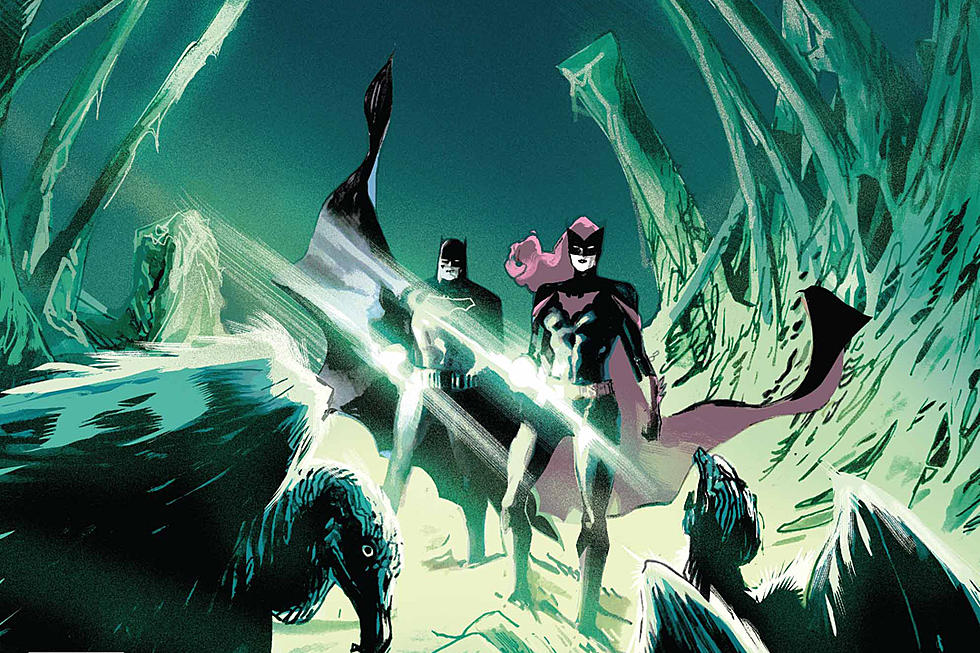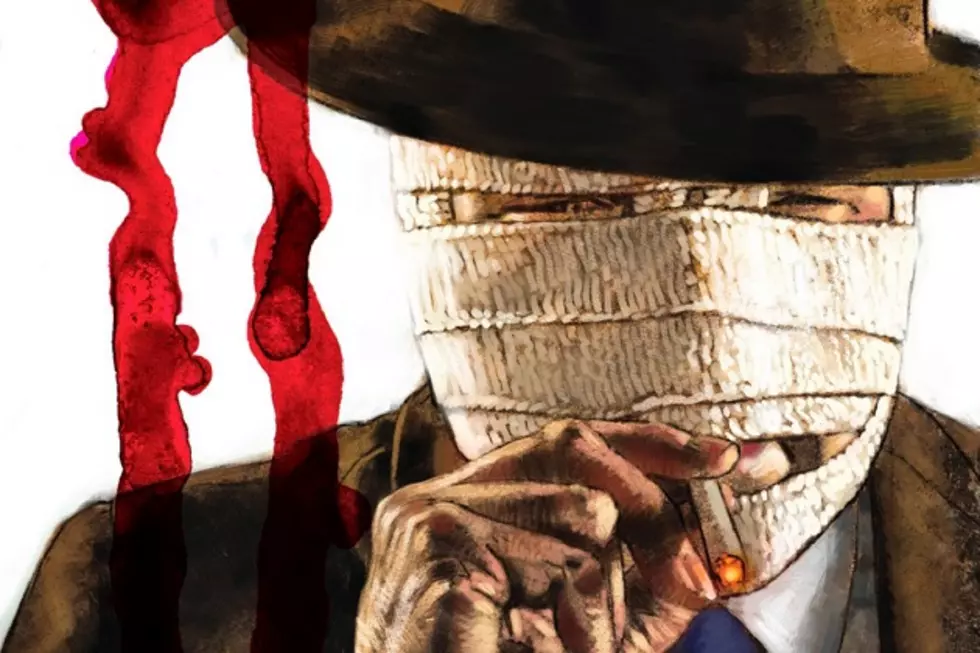![Brubaker and Epting’s ‘Velvet': The Super-Spy Done Right [Review]](http://townsquare.media/site/622/files/2013/10/Velvet-Top.jpg?w=980&q=75)
Brubaker and Epting’s ‘Velvet': The Super-Spy Done Right [Review]
When Ed Brubaker and Steve Epting relaunched Captain America in 2004, they came to the book eager to return the elements of espionage that had been largely absent from the title for years. While most of what we remember are the big events – Bucky’s return, Steve Rogers’ assassination – it was really the spy aspect that drove the story, the behind-the-scenes machinations that made the book so incredibly tense. Now, with Velvet #1 from Image Comics, the team reunite (with Bettie Breitweiser on colors) for another trip into the shadows, a taut thriller about spies, double-crosses, and a middle-aged secretary who’s much more dangerous than she seems to be.
Velvet Templeton is the personal secretary to the Lieutenant Director of Arc-7, a British spy agency formed after World War II that is so secretive, most other clandestine forces aren’t even aware of its existence. When one of the agency’s top field agents is murdered, the Arc-7 turns its attention inward, searching for a mole, or a former agent gone bad. Not content to sit back and watch the men do all the work, Velvet takes matters into her own hands, and Arc-7’s field agents come to learn that Velvet is less Miss Moneypenny and more Modesty Blaise, and the sexy personal assistant who’s been keeping secrets from all of them may just be the most dangerous person in the organization.
Brubaker continues to surprise with how much he can do with so little, keeping his past-tense captions at a minimum and letting the art tell the story, conveying mountains of information in terse dialogue. It seems he’s gotten a taste for female protagonists again: after a memorable run on Catwoman in the early 2000s, pretty much all of his comics work since had a male lead until the 2012 debut of Fatale (though maybe that says less about Brubaker and more about the industry – comics with female leads are hard to come by, and he did sneak in the original movie Angel of Death with Zoe Bell in 2009).
Now, with Velvet, he has another intelligent, vivacious, and deadly star to work with, in an area where he’s always seemed most comfortable, the dark end of the street. (Yes, that was the title of Bru’s first Catwoman collection. Gold star in the air for you.) Though even his weakest superhero work is still high-quality, it just doesn’t come across with the same intense nihilism as his crime or spy books: Captain America (which I maintain was essentially a spy book), Point Blank, Incognito, Gotham Central and Criminal stand head-and-shoulders above his long run on Uncanny X-Men. In Velvet, he’s firing on all cylinders, telling the exact type of story that the man was apparently born to tell: dark and secretive, with only a portion of the bigger picture visible, the rest concealed in shadows. When paired with a skilled collaborator, one whose interests clearly lie in the same type of stories, there’s been no stopping him, and after one issue, that already appears to be the case here.
As to artist Steve Epting, maybe I’m the only one, but I’ve always felt that he’s never gotten the kind of respect he deserves. While his profile has steadily raised from his work on CrossGen’s El Cazador (remember CrossGen? No?), through his razor-sharp action on Captain America and on to the Kirby-tinged sci-fi insanity of Fantastic Four, he seems to have never achieved the “super-star” status of other talents like Leinil Francis Yu or John Cassaday: Cassaday’s and Yu’s names can make a project that, without them, may just as easily break, while Epting just seems regarded as very, very good.
Well, Epting is better than very, very good. In fact, I’d have to say that his talents compare favorably to some of the medium’s greatest masters yesteryear. His anatomy is top-notch, and his characters look realistic while retaining their comic-booky-ness, seeming cool and otherworldly while simultaneously looking like someone you might run across on the way to the store. His layouts are razor-sharp and inventive, and pull from bags of tricks that many others don’t: utilizing negative space in composition; busting characters free from what seem like regimented panel borders for dramatic effect; tilts that range from slight cants to full-on Dutch angles that keep the page in constant motion. And of course there’s his sense of lighting, which gives Velvet the same kind of moody cool that Captain America had in its best moments. As good as Epting is at balls-out action (and he’s really, really good at that), it’s those quiet moments when characters are bathed in slats of shadows from window blinds that saturate the book with an understated drama.
Velvet may be the best version of Epting we’ve seen thus far. Those influences that have always seemed to hide in the background for his superhero work finally come to the forefront, and show us just what kind of master Epting really is. An admitted fan of Jim Holdaway, the British artist who illustrated all of writer Peter O’Donnell’s Modesty Blaise strips from 1963 until the artist’s death in 1970, Epting channels the same type of subdued coolness as Holdaway. Fashionable characters, slick cars, and period-appropriate environs are all rendered in sharp, photorealistic lines that never adhere so strictly to realism that they forget to be interesting. Velvet places him in a continuum of great spy/noir comic artists, from Alex Raymond’s work on Secret Agent X-9, through Holdaway’s Modesty Blaise strips, and on to Stan Drake’s criminally under-appreciated Kelly Green. With only one issue in the tank, Epting is already conducting a master class on form and composition, and we’re damn lucky to get the chance to sit back and take notes.
Drawing upon the history of spy fiction, Brubaker and Epting mix up all their source materials in a bag and produce something equal parts Modesty Blaise, The Sandbaggers, John LeCarre, and Queen & Country; a new concoction of sex, intrigue, and action that grabs you from the very beginning and refuses to let go. An intoxicating debut, Velvet is required reading for anyone with a fondness for cheap spy novels and period-piece espionage; for everyone comfortable at the dark end of the street.
More From ComicsAlliance


![‘Batwoman’ #1 Delivers A Globetrotting Gay Adventure [Review]](http://townsquare.media/site/622/files/2017/03/BW_featured.jpg?w=980&q=75)



![Marguerite Bennett And Steve Epting Relaunch ‘Batwoman’ In 2017 [NYCC 2016]](http://townsquare.media/site/622/files/2016/10/batwoman_featured.jpg?w=980&q=75)
![Brilliant Art, Tremendous Stories and Daring Creators: The 2016 Eisner Award Winners [SDCC 2016]](http://townsquare.media/site/622/files/2016/07/eisner2016.jpg?w=980&q=75)

